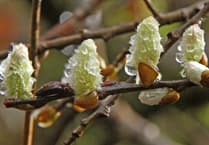IT’S an odd thing really – sometimes I walk for miles without seeing anything interesting, but last week when the sun shone brightly after lunch, I decided to just take a stroll around the village.
Right away, on the field hedge opposite our drive, I spotted a bug climbing across a large leaf.
This was a Hawthorn shield bug and, as the ends of its wings were showing, I assumed that it had just landed.
Normally, as its name suggests, this bug feeds on hawthorn berries and is usually not seen where the shrub is absent, but as these berries are not available yet, they eat the leaves of deciduous trees.
There are a lot of Yarrow plants out in bloom along the hedgerow with clumps of white/pinkish flower-heads on top of tall stems that are surrounded by strongly divided leaves.
The plants have deep, water-gathering roots so when the dreaded hedge strimmer is in action, only the stems and flowers are cut off, leaving the plant to grow again the following year.
Some beautiful Silverweed flowers were in bloom on the rocky ground in a field gateway.
These yellow, five-petalled blooms are the most common of nearly 500 species of the Potentilla family that grow all over Europe.
Their thick roots were extensively eaten, either boiled or roasted, in times of famine in western Britain and were probably cultivated by the working class people for their roots that were parsnip flavoured.
I saw a flash of white in vegetation on the hedge near the village school that turned out to be a Silky Wave moth with a wingspan of around 22mm or just under an inch.
Strange really, as this moth is supposed to be very rare, only sighted in three places in the country and nowhere down in Cornwall – the nearest place would be the Avon Gorge near Bristol.
The Green-veined white butterfly that I spotted on the same length of road is one of several ‘white’ butterflies we see here.
There are two or three generations each year merging into each other, giving the impression that they are on the wing from spring until autumn, and are rarely seen on the cabbage patch.
I went into the fruit frame in the garden to pick any late strawberries that might be there and I was greeted by a wasp that was helping itself to the flesh of a large fruit.
It had eaten so much of the flesh that it was able to stand in a pit in the strawberry whilst it was eating.
Funny really, as I know these creatures live on aphids and small flies before the fruiting season arrives but when I saw that this one was eating one of my berries I took an instant dislike to it.
However, I was grateful that it allowed me to take its picture.




